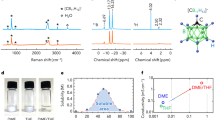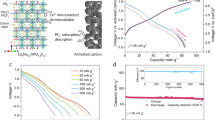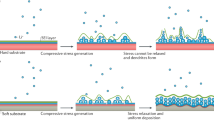Abstract
The development of a rechargeable battery technology using light electropositive metal anodes would result in a breakthrough in energy density1. For multivalent charge carriers (Mn+), the number of ions that must react to achieve a certain electrochemical capacity is diminished by two (n = 2) or three (n = 3) when compared with Li+ (ref. 2). Whereas proof of concept has been achieved for magnesium3,4,5, the electrodeposition of calcium has so far been thought to be impossible6 and research has been restricted to non-rechargeable systems7,8,9,10. Here we demonstrate the feasibility of calcium plating at moderate temperatures using conventional organic electrolytes, such as those used for the Li-ion technology. The reversibility of the process on cycling has been ascertained and thus the results presented here constitute the first step towards the development of a new rechargeable battery technology using calcium anodes.
This is a preview of subscription content, access via your institution
Access options
Subscribe to this journal
Receive 12 print issues and online access
$259.00 per year
only $21.58 per issue
Buy this article
- Purchase on Springer Link
- Instant access to full article PDF
Prices may be subject to local taxes which are calculated during checkout



Similar content being viewed by others
References
Muldoon, J. Quest for nonaqueous multivalent secondary batteries: Magnesium and beyond. Chem. Rev. 114, 11683–11720 (2014).
Amatucci, G. G. et al. Investigation of yttrium and polyvalent ion intercalation into nanocrystalline vanadium oxide. J. Electrochem. Soc. 148, A940–A950 (2001).
Aurbach, D. et al. Prototype systems for rechargeable magnesium batteries. Nature 407, 724–727 (2000).
Yoo, H. D. et al. Mg rechargeable batteries: An on-going challenge. Energy Environ. Sci. 6, 2265–2279 (2013).
Muldoon, J. et al. Electrolyte roadblocks to a magnesium rechargeable battery. Energy Environ. Sci. 5, 5491–5950 (2012).
Aurbach, D., Skaletsky, R. & Gofer, Y. The electrochemical behavior of calcium electrodes in a few organic electrolytes. J. Electrochem. Soc. 138, 3536–3545 (1991).
Sammells, A. F. & Schumacher, B. Secondary calcium solid electrolyte high temperature battery. J. Electrochem. Soc. 133, 235–236 (1986).
Staniewicz, R. J. A study of the calcium-thionyl chloride electrochemical system. J. Electrochem. Soc. 127, 782–789 (1980).
Hayashi, M., Arai, H., Ohtsuka, H. & Sakurai, Y. Electrochemical characteristics of calcium in organic electrolyte solutions and vanadium oxides as calcium hosts. J. Power Sources 119–121, 617–620 (2003).
See, K. A. et al. A high capacity calcium primary cell based on the Ca–S system. Adv. Energy Mater. 3, 1056–1061 (2013).
Lin, M. C. et al. An ultrafast rechargeable aluminium-ion battery. Nature 520, 324–328 (2015).
Xu, K. Electrolytes and interphases in Li-ion batteries and beyond. Chem. Rev. 114, 11503–11618 (2014).
Marcus, R. A. On the theory of oxidation-reduction reactions involving electron transfer. I. J. Chem. Phys. 24, 966–978 (1956).
Budevski, E., Staikov, G. & Lorenz, W. J. Electrochemical Phase Formation and Growth (VCH, 1996).
Gofer, Y. et al. Improved electrolyte solutions for rechargeable magnesium batteries. Electrochem. Solid State Lett. 9, A257–A260 (2006).
Xu, K. Nonaqueous liquid electrolytes for lithium-based rechargeable batteries. Chem. Rev. 104, 4303–4417 (2004).
Ponrouch, A. et al. Non-aqueous electrolytes for sodium-ion batteries. J. Mater. Chem. A 3, 22–42 (2015).
Peled, E., Menahem, C., Bar Tow, D. & Melman, A. The electrochemical behavior of alkali and alkaline earth metals in nonaqueous battery systems—the solid electrolyte interphase model. J. Electrochem. Soc. 143, L4 (1996).
Aurbach, D. Review of selected electrode–solution interactions which determine the performance of Li and Li ion batteries. J. Power Sources 89, 206–218 (2000).
Xu, K. & von Cresce, A. Interfacing electrolytes with electrodes in Li ion batteries. J. Mater. Chem. 21, 9849–9864 (2011).
Ponrouch, A., Marchante, E., Courty, M., Tarascon, J. M. & Palacín, M. R. In search of an optimized electrolyte for Na-ion batteries. Energy Environ. Sci. 5, 8572–8583 (2012).
Nie, M. & Lucht, B. L. Role of lithium salt on solid electrolyte interface (SEI) formation and structure in lithium ion batteries. J. Electrochem. Soc. 161, A1001–A1006 (2014).
Guyomard, D. & Tarascon, J. M. Li metal‐free rechargeable LiMn2O4/carbon cells: Their understanding and optimization. J. Electrochem. Soc. 139, 937–948 (1992).
Sano, H., Senoh, H., Yao, M., Sakaebe, H. & Kiyobayashi, T. Mg2+ storage in organic positive-electrode active material based on 2,5-dimethoxy-1,4-benzoquinone. Chem. Lett. 41, 1594–1596 (2012).
Fauth, F., Peral, I., Popescu, C. & Knapp, M. The new Material Science Powder Diffraction beamline at ALBA Synchrotron. Powder Diffraction 28, S360–S370 (2013).
Rodríguez-Carvajal, J. Recent advances in magnetic structure determination by neutron powder diffraction. Physica B 192, 55–69 (1993).
Masson, O., Dooryhee, E., Cheary, R. W. & Fitch, A. N. The high resolution powder diffraction beam line at ESRF. Mater. Sci. Forum 132, 378–381 (2001).
Acknowledgements
Authors are grateful to F. Fauth for his assistance during data collection at the ALBA Synchrotron. The authors thank the Toyota Battery Research division at Higashi Fuji (M6) for their financial support.
Author information
Authors and Affiliations
Contributions
M.R.P. and F.B. conceived and coordinated the study, A.P. designed, performed and analysed the electrochemical experiments and C.F. analysed diffraction data. All authors discussed the results and A.P. and M.R.P. wrote the paper with contributions from all authors.
Corresponding author
Ethics declarations
Competing interests
The authors declare no competing financial interests.
Supplementary information
Supplementary Information
Supplementary Information (PDF 625 kb)
Rights and permissions
About this article
Cite this article
Ponrouch, A., Frontera, C., Bardé, F. et al. Towards a calcium-based rechargeable battery. Nature Mater 15, 169–172 (2016). https://doi.org/10.1038/nmat4462
Received:
Accepted:
Published:
Issue Date:
DOI: https://doi.org/10.1038/nmat4462
This article is cited by
-
A rechargeable calcium–oxygen battery that operates at room temperature
Nature (2024)
-
Calcium-mediated nitrogen reduction for electrochemical ammonia synthesis
Nature Materials (2024)
-
Asymmetric Electrolytes Design for Aqueous Multivalent Metal Ion Batteries
Nano-Micro Letters (2024)
-
Investigation of the electrochemical intercalation of Ca2+ into graphite layer carbon nano filaments as a novel electrode material for calcium-ion batteries
SN Applied Sciences (2023)
-
Ca2+ Solvation and Electrochemical Solid/Electrolyte Interphase Formation Toward the Multivalent-Ion Batteries
Arabian Journal for Science and Engineering (2023)



